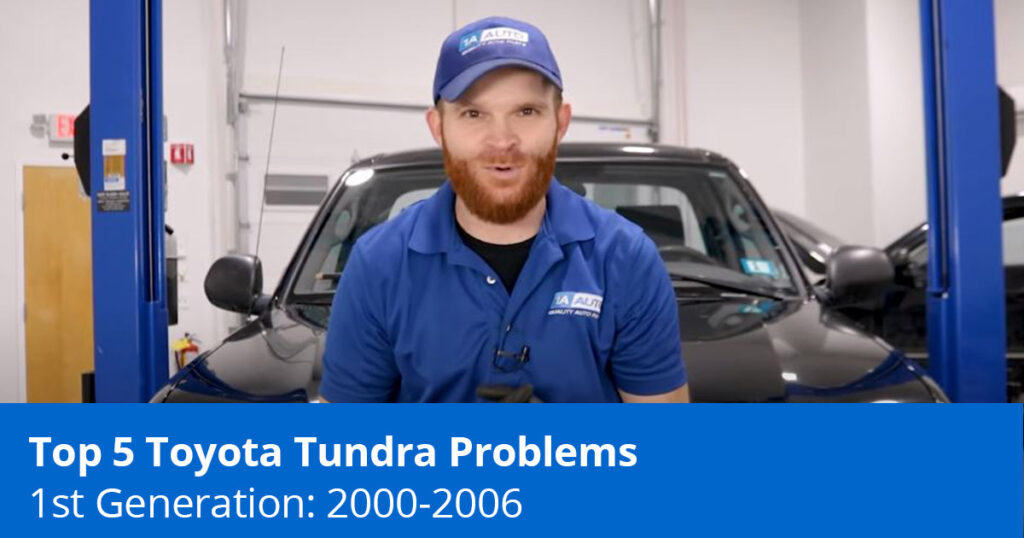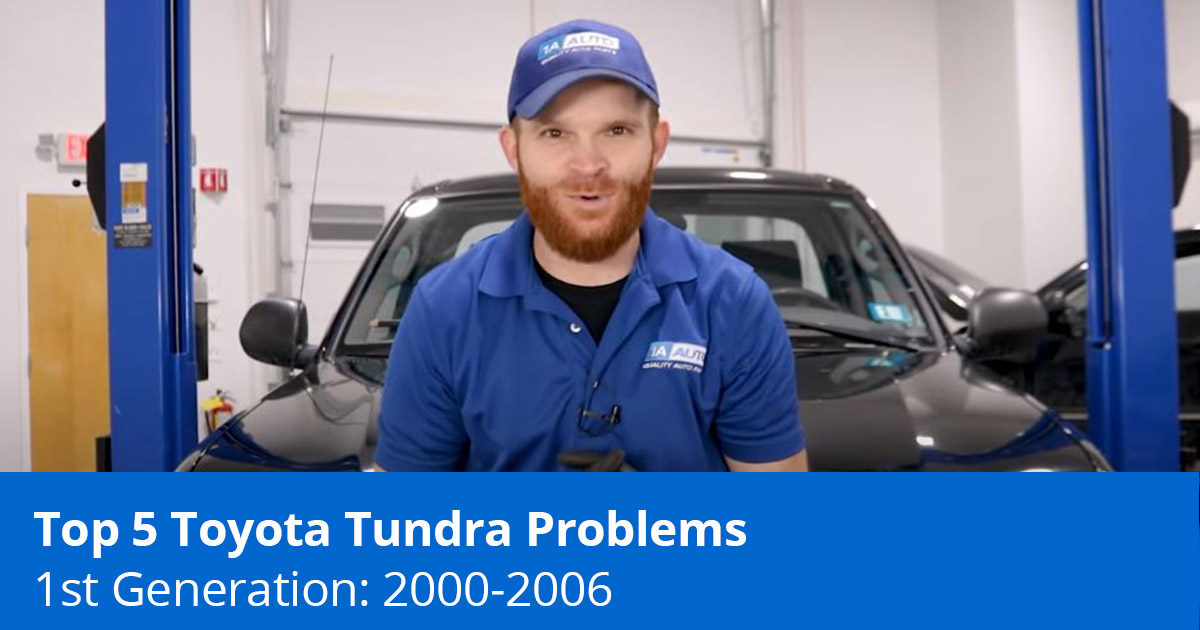
The 1st Gen Tundra is a popular pickup truck. Like many vehicles, it has its common problems. This post reviews the top 5 problems on the Toyota Tundra, years 2000 to 2006.

Top Issues with the 1st Gen Toyota Tundra (2000 to 2006)
1. Exhaust Manifold Leaks
Symptoms of an Exhaust Manifold Leak
- Ticking noise during the first 30 seconds to a minute during start-up
Causes of Exhaust Manifold Leaks
Sometimes the mounting bolts rot and break and can create a leak. The exhaust manifold may also crack and cause a leak. This is more common on the 8-cylinder engine.
How to Fix an Exhaust Manifold Leak
Look at both manifolds for broken hardware. If there is no broken hardware, remove the manifold. Check the manifold for cracks or a fine line in the manifold, which is probably a crack. If there is an issue with the exhaust manifold, replace it.
2. Secondary Air Injection Pump Failure
Symptoms of Secondary Air Pump Failure
- Small decrease in fuel economy (more trips to the gas station)
- Loud whirring or humming noise from the pump
- Check engine light related to the pump
Causes of Secondary Air Pump Failure
The secondary air injection pump, also known as a smog pump, is a part of the emissions system. It pumps air to the catalytic convertor during start-up to heat it up faster. Issues with the secondary air pump is more likely to happen on the 4.7L V8 engine.
How to Fix Secondary Air Pump Failure
The secondary air injection pump is below the air intake along the belly of the engine below the air intake.
Test the pump for power and ground. Make sure the hoses connected to it aren’t restricted. If the pump is defective, replace it.
3. Internal Radiator Issues—Coolant Mixing with the Transmission Fluid
Note: This issue is specific to the 1st Gen Tundra’s with automatic transmissions.
Symptoms of Radiator Problems on the 1st Gen Tundra
- Transmission slipping—RPMs increase but the vehicle’s speed does not
- Pink milkshake-like coolant under the radiator cap, in the coolant overflow tank, or on the transmission dipstick.
Causes of Internal Radiator Issues
The radiator can rupture internally and mix the coolant into the transmission system by the transmission cooler lines that sit in the tank on the radiator.
How to Fix Internal Radiator Problems
This repair requires replacing the radiator, flushing the cooling system, and possibly rebuilding or replacing the transmission. There may be no damage to the transmission if this issue is found early. Make sure all the fluids are drained. Any coolant inside the transmission could cause this issue again.
4. Oxygen (O2) Sensors
Symptoms of Bad O2 Sensors
- Check engine light
- Lower fuel economy
- Black smoke expelling out the tail pipe
Causes of Bad O2 Sensors
The O2 sensor calculates how much air/fuel is in the exhaust that’s exiting the engine so the computer can make adjustments for combustion. If there is an issue with any of the four O2 sensors on the 2000 to 2006 Tundra, the symptoms above can occur.
Contaminants inside the exhaust system can wear out the O2 sensors faster. Contaminants can enter the exhaust system from engine leaks, such as the engine oil leaking into the combustion chamber, and coolant leaks. The 1st gen Toyota Tundra has two banks, meaning it has two exhaust manifolds, each with their own upstream and downstream O2 sensors monitoring the exhaust. The upstream O2 sensors are placed before the catalytic convertor and close to the exhaust manifolds, and the downstream O2 sensors are placed behind the catalytic convertor.
How to Fix Faulty O2 Sensors
Use a scanner to read the OBD-II trouble codes. If the code says “bank 1 sensor 1” for example, this means an upstream O2 sensor on bank 1 needs to be replaced. If there is an exhaust leak closer to the engine and before the O2 sensors, a code for a lean running condition will likely appear. A lean running condition code may also appear for a clogged or broken catalytic convertor.
5. Broken Ball Joints

Symptoms of a Bad Ball Joint on the 1st Gen Toyota Tundra
- Loose steering that doesn’t feel as tight and stable, especially like turning corners or driving over bumps
- Front end clunking
- Front end creaking or squeaking
Causes of a Bad Ball Joint
The ball inside the ball joints needs to be able to pivot around the joint. If the ball is able to loosen, it can tear the ball joint, loosen, and pop out of the socket. If the boot opens, outside elements can collect inside and create binding.
How to Fix a Bad Ball Joint
The 2000 to 2006 Toyota Tundra has a lower and upper ball joint on each side.
Grab the wheel from the 12 and 6 o’clock position and feel for play. This can also be an indicator of a bad wheel hub bearing, but on the 1st gen Tundra it’s likely the ball joint. If the ball joint is broken, replace it.
6. Emergency Brake Issues

Symptoms of E-Brake Problems on the 2000 to 2006 Toyota Tundra
The e-brake doesn’t work—truck still moves after applying the e-brake or does not move/release the e-brake.
Causes of E-Brake Problems
The e-brake can seize up on the 2000 to 2006 Toyota Tundra. The pivots points and e-brake cables can fail and stay stuck in open or closed positions. This can happen from a lack of use or moisture corroding metal parts.
Brake pulsating or noises from the rear brakes
How to Fix E-Brake Problems
Steps for Fixing E-Brake Failure on the 2000 to 2006 Toyota Tundra
- Remove the Brake Shoes and Brake Drum
This repair requires removing the brake drum and the brake shoes to access the pivot areas inside the brakes.
- Disassemble the Pivot Point
Disassemble the pivot point and remove it from the backing plate.
- Clean the Pivot Point
Clean the pivot point of any rust, corrosion, or debris.
- Inspect the Brake Parts
With the brakes disassembled, inspect the amount of friction pad material left on the brake shoes and inspect the brake drums for signs of overheating, which is indicated by spots on the drum. Worn out brake shoes can cause brake pulsation. If the brake shoes and/or the brake drum is worn, replace them.
- Lubricate and Reassemble the Pivot Point
Re-lubricate the parts and reassemble the pivot point
Fix Your Own 1st Gen Tundra
Check 1A Auto’s video library and learn how to do many repairs yourself on the 2000 to 2006 Toyota Tundra like the brakes and headlights.
1st Generation Toyota Tundra Model Years
- 2000 Toyota Tundra
- 2001 Toyota Tundra
- 2002 Toyota Tundra
- 2003 Toyota Tundra
- 2004 Toyota Tundra
- 2005 Toyota Tundra
- 2006 Toyota Tundra
Related Content
- Think You Have An Exhaust Manifold Leak?
- Common Bad Radiator Symptoms
- Check Engine Light and P0420 and P0430 Codes
- Bad Ball Joint? [Expert Advice to Diagnose & Fix]
Shop 1st Gen Toyota Tundra Parts

